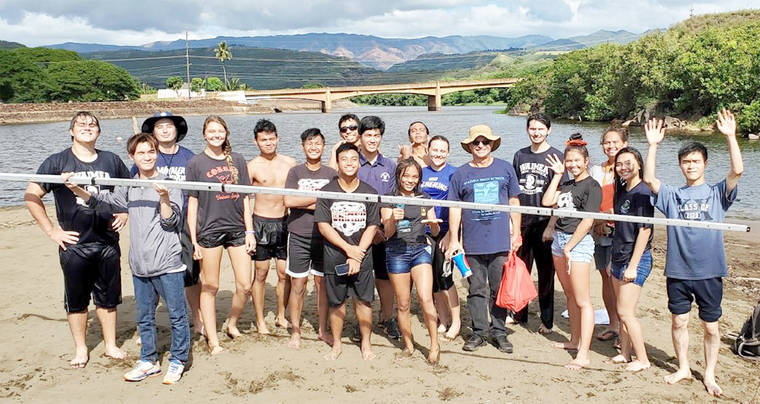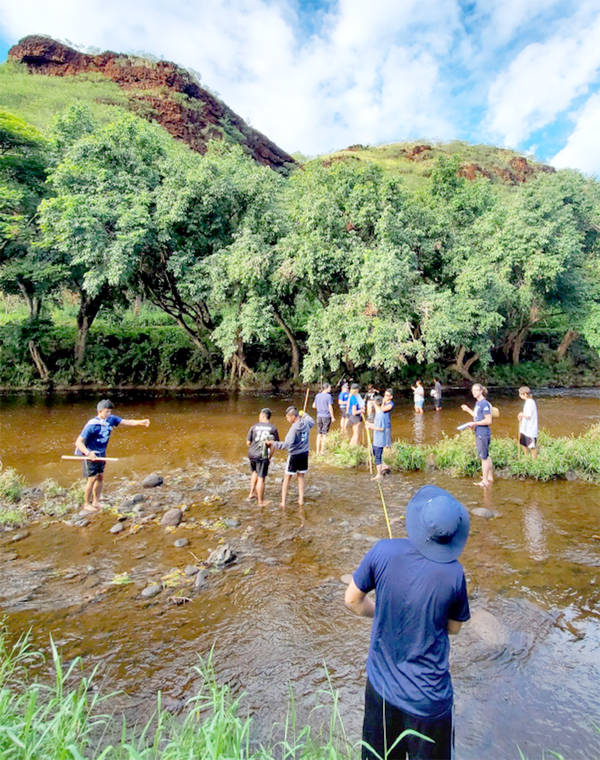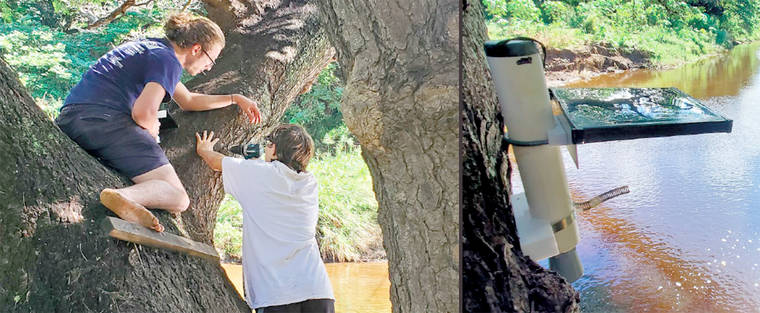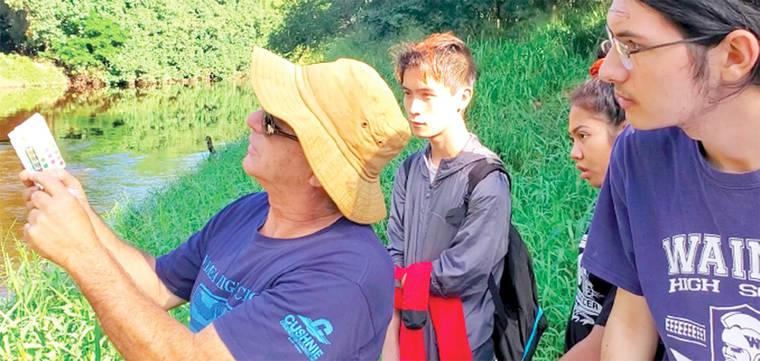A team of students and teachers from Waimea High School convened Friday at Kiki A Ola Bridge in Waimea Valley. As the morning sun broke over the ridges of Waimea Canyon, math and physics teacher, Daniel Shyles, welcomed the group to the first field trip of the Waimea Watershed Monitoring Project.
Shyles reminded the students of the intention of the endeavor, “Our home does not end at our doorstep, our school does not end at the edge of campus, and when we recognize nature as an extension of ourselves, we are better equipped to be its stewards.”
The day’s objectives included measuring water quality and physical characteristics of the river and deploying sensors to continuously monitor parameters such as water level, temperature, and ambient light levels in the water column.
Pelika Andrade, co-founder of Na Kilo ‘ ina, an educational organization dedicated to fostering people’s awareness and observation of ‘aina, or our source of sustenance, and their understanding of the islands’ ecosystems and natural processes, thus creating a deeper relationship with nature.
Andrade instructed students on water sampling near the riverbed to determine to what extent denser saline water had collected on the bed due to high tidal events.
Waimea High School natural resources teacher Charles Foulks led students in measuring the river’s pH and levels of ammonium, nitrites, and nitrates, while math and engineering teacher, Kawika Wellington, coordinated measurements of the river’s volumetric flow rate.
Waimea High School students Gavin Mockett, Leslie Uri, Kepler Niccore, and Wendell Batangan recorded measurements of the water level and stream velocity which was read by Jaymin Kali-Palau, Kalaea El Saieh-Rowe, Julienne Gawaran, Fred Adella, Alex and Carlton Hung, among others. Julien Wooten, a junior at Waimea High School, installed the project’s first permanent sensor to continuously monitor the water level of the river.
The sensor, provided by Dr. Brian Glazer and Stanley Lio from the University of Hawaii at Mānoa’s Department of Oceanography, is equipped with a cellular modem capable of transmitting water level data remotely to an open source online database.
In conjunction with regular surveys of water quality and the ecology of the riparian ecosystem, including monitoring for ‘o‘opu and invasive species, the student-led project aims to form a contiguous network of internet-connected sensors along the Waimea watershed, providing real-time data to the community to assist with environmental management goals.
The planned network will place sensors at key points along the watershed such as the headwaters of the Alaka‘i Plateau, confluences of streams and ditch intakes within Waimea Canyon, and the Waimea Town estuary.
The network will enable users to monitor phenomena such as large rain events via changes in water level caused by a pulse of rainwater flowing from Mt. Wai‘ale‘ale to the river mouth.
It will also detect changes in river behavior and chemistry as flow mechanics evolve due to redistribution of water from irrigation ditches to Waimea River expected following the historic mediation agreement in 2017 among the West Kauai Watershed Alliance Po ‘Ai Wai Ola and environmental law nonprofit Earthjustice, the Kekaha Agriculture Association, Kaua‘i Island Utility Cooperative, and the Department of Hawaiian Homelands.
Under the agreement, the parties agreed to restore tens of millions of gallons of water per day to Waimea River in order to sustain the river ecosystem and services such as farming in Waimea Valley.
Waimea High School aims to provide stakeholders with data to inform and help enforce expectations set forth in the agreement.
The Waimea Watershed Monitoring Project is an extension of the Natural Resources and Technology academies of Waimea High School. The academies facilitate opportunities for students to engage in hands-on application of sciences and humanities they learn on campus.
This project is one example of how students are leveraging interdisciplinary knowledge, from institutional science to traditional cultural knowledge, to make a lasting impact within their community, and establish Waimea High School as a hub for innovation and solutions on the Westside.








